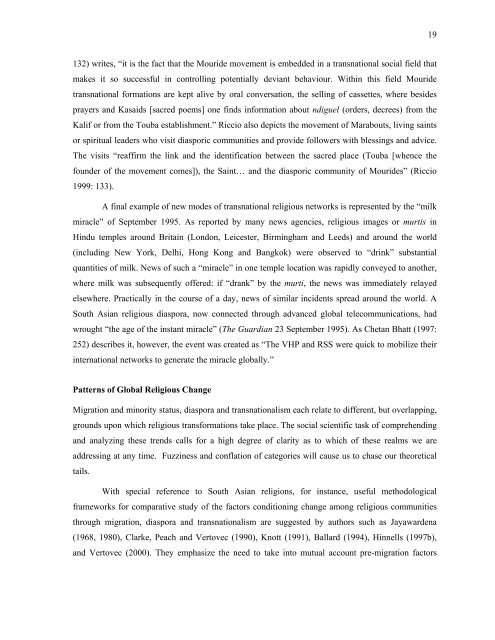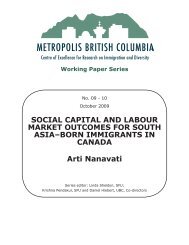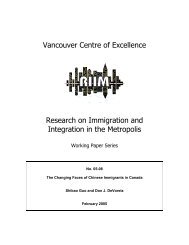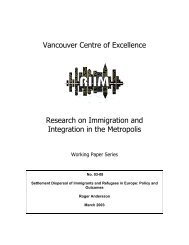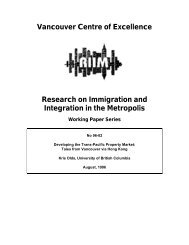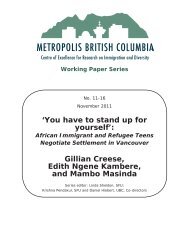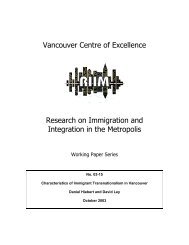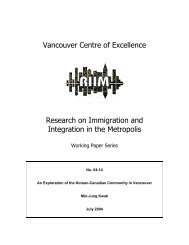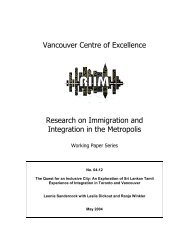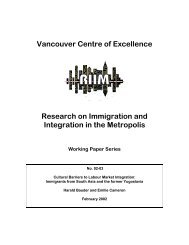Religion in Migration, Diasporas and Transnationalism - Metropolis BC
Religion in Migration, Diasporas and Transnationalism - Metropolis BC
Religion in Migration, Diasporas and Transnationalism - Metropolis BC
You also want an ePaper? Increase the reach of your titles
YUMPU automatically turns print PDFs into web optimized ePapers that Google loves.
19<br />
132) writes, “it is the fact that the Mouride movement is embedded <strong>in</strong> a transnational social field that<br />
makes it so successful <strong>in</strong> controll<strong>in</strong>g potentially deviant behaviour. With<strong>in</strong> this field Mouride<br />
transnational formations are kept alive by oral conversation, the sell<strong>in</strong>g of cassettes, where besides<br />
prayers <strong>and</strong> Kasaids [sacred poems] one f<strong>in</strong>ds <strong>in</strong>formation about ndiguel (orders, decrees) from the<br />
Kalif or from the Touba establishment.” Riccio also depicts the movement of Marabouts, liv<strong>in</strong>g sa<strong>in</strong>ts<br />
or spiritual leaders who visit diasporic communities <strong>and</strong> provide followers with bless<strong>in</strong>gs <strong>and</strong> advice.<br />
The visits “reaffirm the l<strong>in</strong>k <strong>and</strong> the identification between the sacred place (Touba [whence the<br />
founder of the movement comes]), the Sa<strong>in</strong>t… <strong>and</strong> the diasporic community of Mourides” (Riccio<br />
1999: 133).<br />
A f<strong>in</strong>al example of new modes of transnational religious networks is represented by the “milk<br />
miracle” of September 1995. As reported by many news agencies, religious images or murtis <strong>in</strong><br />
H<strong>in</strong>du temples around Brita<strong>in</strong> (London, Leicester, Birm<strong>in</strong>gham <strong>and</strong> Leeds) <strong>and</strong> around the world<br />
(<strong>in</strong>clud<strong>in</strong>g New York, Delhi, Hong Kong <strong>and</strong> Bangkok) were observed to “dr<strong>in</strong>k” substantial<br />
quantities of milk. News of such a “miracle” <strong>in</strong> one temple location was rapidly conveyed to another,<br />
where milk was subsequently offered: if “drank” by the murti, the news was immediately relayed<br />
elsewhere. Practically <strong>in</strong> the course of a day, news of similar <strong>in</strong>cidents spread around the world. A<br />
South Asian religious diaspora, now connected through advanced global telecommunications, had<br />
wrought “the age of the <strong>in</strong>stant miracle” (The Guardian 23 September 1995). As Chetan Bhatt (1997:<br />
252) describes it, however, the event was created as “The VHP <strong>and</strong> RSS were quick to mobilize their<br />
<strong>in</strong>ternational networks to generate the miracle globally.”<br />
Patterns of Global Religious Change<br />
<strong>Migration</strong> <strong>and</strong> m<strong>in</strong>ority status, diaspora <strong>and</strong> transnationalism each relate to different, but overlapp<strong>in</strong>g,<br />
grounds upon which religious transformations take place. The social scientific task of comprehend<strong>in</strong>g<br />
<strong>and</strong> analyz<strong>in</strong>g these trends calls for a high degree of clarity as to which of these realms we are<br />
address<strong>in</strong>g at any time. Fuzz<strong>in</strong>ess <strong>and</strong> conflation of categories will cause us to chase our theoretical<br />
tails.<br />
With special reference to South Asian religions, for <strong>in</strong>stance, useful methodological<br />
frameworks for comparative study of the factors condition<strong>in</strong>g change among religious communities<br />
through migration, diaspora <strong>and</strong> transnationalism are suggested by authors such as Jayawardena<br />
(1968, 1980), Clarke, Peach <strong>and</strong> Vertovec (1990), Knott (1991), Ballard (1994), H<strong>in</strong>nells (1997b),<br />
<strong>and</strong> Vertovec (2000). They emphasize the need to take <strong>in</strong>to mutual account pre-migration factors


